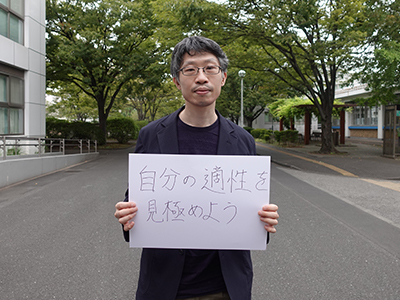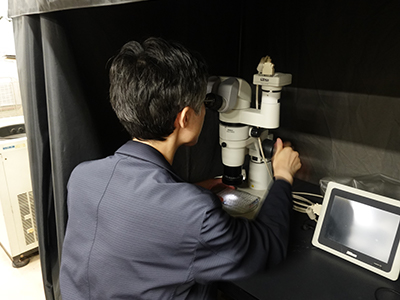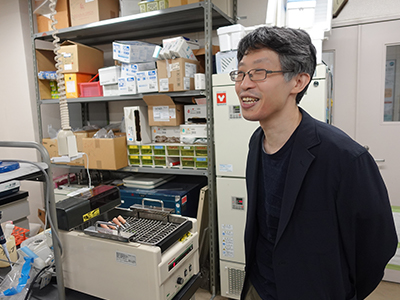People who convey voices from the sea
People who convey voices from the sea

Objects of a size that can never be seen by the human eye
catch visually
Faculty of Marine Resources and Environment Department of Marine Environmental Science Kimihiko Okai Associate Professor
the human eye can never see
something of a level that cannot be
catch visually
Faculty of Marine Resources and Environment Department of Marine Environmental Science Kimihiko Okai Associate Professor

Biography
Kimihiko Okai(Okai Masahiko)
Faculty of Science Division of Marine Environmental Science Associate Professor
- Q What department do you belong to?
↓
- Department of Marine Environmental Science.Broadly speaking, there are faculty members in oceanography and marine biology. In oceanography, we analyze the composition of the sea, ocean currents, climate, etc., and we target the seas, seabeds, and coastal areas around the world.Marine biology takes a behavioral to molecular approach to a wide range of subjects, including fish, cetaceans, algae, jellyfish, mollusks, plankton, and microorganisms.Students will be able to experience a lot of lectures and practical training, so I believe that they will be able to find areas of interest among them.
- Q What kind of classes do you teach?
↓
- First-year students are in charge of chemistry, second-year students are in charge of chemical experiments, and third-year students are in charge of environmental biochemistry experiments. In first-year chemistry, I am in charge of the field of organic compounds, which is learned as a university education, and I mainly explain the nomenclature and detailed mechanisms of reactions. In the second-year chemistry experiment, I am in charge of "analyzing the functional groups of organic compounds", and through actual experiments, I understand the characteristics of the compounds that I learned in class. In the third-year environmental biochemistry experiment, I am in charge of "Ethanol fermentation by marine yeast", and I will investigate the process of ethanol fermentation from glucose using the properties of microorganisms and analysis equipment.
- Q What kind of research are you doing?What do you find interesting about that research?
↓
- We are investigating how microorganisms involved in environmental purification and industrial use and the enzymes in them work.PAHs (polycyclic aromatic hydrocarbons) generated by incomplete combustion of petroleum are toxic and persistent, and some even cause cancer. We are looking for microorganisms that decompose PAHs in nature, and we are investigating the specific mechanism by which enzymes decompose PAHs.Seaweed farming is popular in Japan, but the non-edible parts are simply discarded.The non-edible parts contain polysaccharides, and they search for microorganisms that decompose polysaccharides, and use the enzymes contained in them to decompose them into oligosaccharides and monosaccharides.It is said that monosaccharides are useful for ethanol fermentation, and oligosaccharides are useful for reducing calorie value, moisturizing whitening effect, antioxidant action, and improving the intestinal environment.Enzyme research uses a technique called crystal structure analysis to obtain information at the molecular level (10-10We are looking at the decomposition process at the square m).The interesting thing about this research method is that it allows us to visually capture things that are too large for the human eye to see.

- Q What inspired you to do this research?Please tell us about the episodes that you fell in love with, the episodes that lead to your current research, etc.
↓
- When I was doing an experiment with a student, I became interested in the structure of a low-molecular-weight compound based on NMR (nuclear magnetic resonance) data.The structure of proteins can also be determined by NMR, but when it comes to large proteins, it is more common to make crystals and analyze the structure than to obtain NMR data, and I followed that trend.It took me several years to create the crystals, not just after I entered the laboratory.It was necessary to roll the crystals with the crystallization kit as soon as possible after acquiring the enzyme, so I sometimes stayed overnight, but it was quite fun to have friends who were experimenting together.In the meantime, I have been thinking about what kind of things I want to target instead of methods, and I think it would be good to realize that proteins that can be used industrially are contributing to society, rather than proteins that are fundamental to life phenomena. thought.
- Q What number of SDGs is your research related to?How will your research help society?Also, what kind of occupation or work do you think it will lead to?
↓
- Number 9 and number 14. Number 9 is "Let's build a foundation for industry and technological innovation."This research will be linked to the fisheries and food industries. Number 14 is "Let's protect the richness of the sea", and we believe that purifying or preventing pollution will help maintain the ecosystem and human health over the long term.This research is relevant to the water treatment industry, as water treatment facilities perform microbial treatment in aeration tanks and the like.
- Q What are your future goals as a researcher?What kind of "dream" do you want to give to the world through your research?It doesn't have to be realistic.Please tell me your dream of becoming a teacher.
↓
- I would like to send out even one value-added product that can contribute to society.For example, oligosaccharides obtained by decomposing seaweed polysaccharides are sold as products, but they are very expensive and cannot be taken casually.I think it would be good if we could develop an enzyme that can be made inexpensively and sell it as a supplement.
- Q: Looking ahead to 2030, what kind of research would you like to do with incoming students?
↓
- There are still many untapped substances and microorganisms in the fisheries field.Also, as the times change, new environmental pollutants and effective substances may emerge.I would like to keep my antennae up so that I can respond to what is needed in the current era, not just the current subject, and to conduct research that can return something beneficial to society.I would like to walk with the students so that I can share it.








